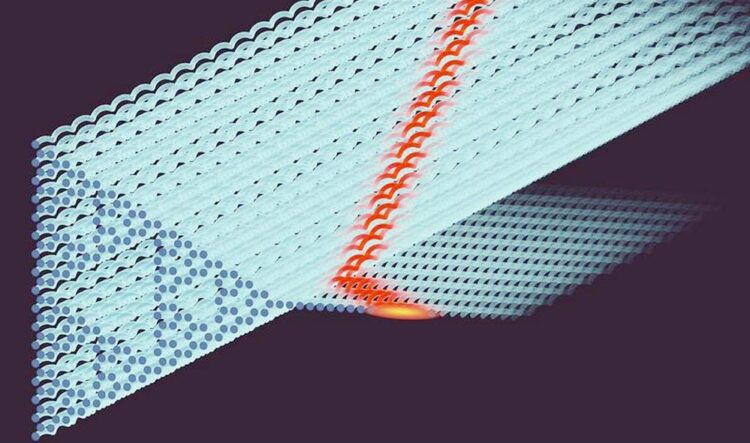Fractal Drive – A Lack of Bulk Gives Photons an Edge

Fractal topological insulator: The synthetic photonic material composed of a self-similar arrangement of waveguides protects and speeds up light signals traveling along its edges
Credit: Tobias Biesenthal / Universität Rostock
Researchers from the University of Rostock have developed a novel type of micro-structured material that enhances the speed of light signals while keeping them protected from scattering. Their discovery will be published online by the renowned journal “Science” on Thursday, 12 May, 2022.
Photonic topological insulators (PTIs) are artificial materials that conduct light along their edges, yet block it from traversing their interior. These “superconductors for photons” have fascinated Prof. Alexander Szameit of the University of Rostock for a long time. “Ever since our first implementation of a topological insulator for light, we have explored how these peculiar systems can be best utilized,” the head of the solid-state optics group remembers. Yet, while photonic topological insulators can ‘protect’ light propagating along precisely defined paths from scattering, their excellent resistance towards imperfections or external perturbations typically comes at a cost. “The periodic structures that we typically use to construct PTIs tend to slow down the light which they are supposed to transport,” first author Tobias Biesenthal outlines the motivation behind his experiments, “In trying to protect them, we are loading the signals with unwanted ballast.”
The solution that the team of researchers came up with draws on the strange and beautiful world of so-called fractals. First formalized as a mathematical concept by Benoit Mandelbrot in 1967 in trying to understand why the measured length of the British coast gains hundreds of kilometers seemingly out of nowhere when more detailed maps are being used, these structures abound in nature. For example, the arrangement of twigs statistically resembles the way in which the larger boughs branch out from the trunk of a tree. Self-similarity across scales therefore lies at the heart of fractals, meaning that any section of a system reproduces the characteristics of the whole. In turn, “exact” fractals identically repeat their structure ad infinitum. A well-known example is the Sierpinski triangle that can be readily obtained by nesting ever-smaller replicas of an equilateral triangle into one another. Paradoxically, even if it is sketched on a sheet of paper, this structure does not actually cover any area: Rather, each of its points can be shown mathematically to belong to one of the manifold edges.
In close collaboration with partners from the Israel Institute of Technology Technion in Haifa and Zhejiang University in China, the Rostock scientists resolved the long-standing question whether topological insulators can be constructed without bulk material, and leveraged self-similarity to relieve light signals of their burden. “Like a stone skipping across the waves of the Baltic Sea, light beams can race along the edges of our fractal material without seeing much of its interior,” explains Dr. Matthias Heinrich, lead author of the work. “The crucial difference is that, while such a stone loses its energy with every bounce and eventually sinks, light in such a material is protected from scattering: In principle, it could keep going indefinitely.”
The successful international collaboration has substantially advanced fundamental research on topological photonics. While several formidable challenges remain until these insights will find their way into consumer products, the physicists’ newest discovery has great potential for a wide range of innovative applications such as topologically protected high-speed photonic circuitry and entirely new class of versatile synthetic materials.
This research was funded by Deutsche Forschungsgemeinschaft and the Alfried Krupp von Bohlen und Halbach-Foundation.
Contact:
Dr. Matthias Heinrich
Experimental Solid-State Optics Group
Institute for Physics
University of Rostock
Tel.: +49 381 498-6796
E-Mail: matthias.heinrich@uni-rostock.de
Media Contact
All latest news from the category: Physics and Astronomy
This area deals with the fundamental laws and building blocks of nature and how they interact, the properties and the behavior of matter, and research into space and time and their structures.
innovations-report provides in-depth reports and articles on subjects such as astrophysics, laser technologies, nuclear, quantum, particle and solid-state physics, nanotechnologies, planetary research and findings (Mars, Venus) and developments related to the Hubble Telescope.
Newest articles
Faster, more energy-efficient way to manufacture an industrially important chemical
Zirconium combined with silicon nitride enhances the conversion of propane — present in natural gas — needed to create in-demand plastic, polypropylene. Polypropylene is a common type of plastic found…

Energy planning in Ghana as a role model for the world
Improving the resilience of energy systems in the Global South. What criteria should we use to better plan for resilient energy systems? How do socio-economic, technical and climate change related…

Artificial blood vessels could improve heart bypass outcomes
Artificial blood vessels could improve heart bypass outcomes. 3D-printed blood vessels, which closely mimic the properties of human veins, could transform the treatment of cardiovascular diseases. Strong, flexible, gel-like tubes…





















